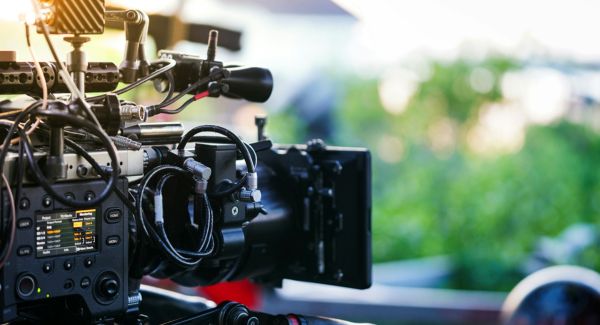Expert insights from DP Giovani Lampassi on pre-production, lighting, and visual storytelling.
by Carole Dean
As an indie filmmaker, you know that collaboration is key to bringing a vision to life. But have you ever wondered what a cinematographer really needs from a producer to make magic happen on screen? How can you, as a producer, empower your director of photography (DP) to craft the best possible images for your story?
Giovani Lampassi is an experienced director of photography who counts hit shows like Brooklyn Nine-Nine, Veronica Mars, Unstable, and more to his credit. He shared with us in our Learn Producing Class his insights on the cinematographer’s process—from initial script breakdown to the final shoot.
This masterclass in cinematography will help you understand the technical and creative needs of your DP, ensuring that your collaboration results in stunning visuals that serve your story.
The Journey from Script to Screen
“What I do normally is I’ll get a script, and I just start jotting down notes,” says Giovani. “I highlight things that are important to me as a cinematographer.”
This initial phase is where a DP begins their deep dive into the story. While these notes aren’t immediately shared with the director or producers, they serve as a foundation for later discussions.
He explains that his process is all about absorbing the material and then refining his thoughts through collaboration. “I want to hear what their ideas are first,” he says, “and then through collaboration, I’ll suggest things like a whip pan here or atmospheric smoke there.”
This stage is crucial for producers to understand. The more time and clarity a cinematographer has during prep, the more effectively they can execute the vision.
Building the Visual World: Research & Reference Images
Once he has a strong grasp of the script, he begins gathering reference images. “If it’s a script that’s set in a particular location, I start looking at what that environment actually looks like in reality,” he explains. “For example, if the script is set in New England, I’ll pull images of real interiors and exteriors to ground the film in authenticity.”
Shot Deck is one of Giovani’s favorite tools. “It’s the most useful tool for the visual side of film because you can type in any search string like ‘night as blue,’ ‘day look orange,’ or even something as abstract as ‘ominous lighting,’ and you’ll get a whole collection of reference images.”
By assembling these visuals into a lookbook, he builds a roadmap for the film’s aesthetic, ensuring that the final product aligns with the director’s vision and the script’s tone.
Choosing the Right Camera & Equipment
“The camera is really becoming our film stock,” he notes. This means that choosing the right camera is one of the most critical decisions a cinematographer will make. “I’ll put together a comparison between cameras like the Venice and the Alexa, breaking down their different aspect ratios and color sciences.”
However, it’s not always as simple as choosing the best camera for the job. “Oftentimes, in streaming and network productions, the studio will dictate the cameras we can use,” he explains. “If you want to use something outside of that list, you need approval from a bunch of tech people who only look at numbers on a page.”
For indie filmmakers, this underscores the importance of understanding the technical constraints that come with distribution requirements. Producers should ensure that their cinematographer has access to the right tools within budget and industry guidelines.
Lenses: Defining the Look
Once the camera is selected, the DP moves on to lenses. “I love using Cooke S4s. They have great flare characteristics, beautiful color, and a fantastic bokeh. They’re my go-to lenses.” However, different projects call for different choices. “When you don’t have a film stock to rely on, your lenses and camera become that film stock. You have to know how to use them to craft the look you want.”
Understanding how different lenses affect the image—from sharpness and color rendition to depth of field—is an essential skill for both DPs and producers. Ensuring the right lenses are available can have a significant impact on the final film.
Framing & Composition: Crafting the Cinematic Language
After assembling the technical foundation, he shifts his focus to framing and composition. “How do I see this show? Do I see a lot of look space? Should it feel claustrophobic? Should we only see one eye in close-ups? Do we use silhouettes?”
These decisions are driven by the story. “The most important thing is supporting the script. If you’re shooting a comedy and decide to light it like film noir, are you really serving the story?” Giovani stresses that every decision—from framing to lighting—must enhance the narrative.
As a producer, your role is to ensure that the cinematographer has the freedom and resources to make these creative decisions while staying true to the overall vision.
Lighting: Setting the Mood
“Once I figure out the visual style, I start talking to my chief lighting technician about what lights we’ll need,” he explains. “Are we using soft lights? Hard lights? What’s the location like? Do we need large sources far away, or do we need smaller practical lights?”
Lighting is one of the most powerful tools in a cinematographer’s arsenal. “The lighting style has to support the camera and the script. Everything needs to mesh together.”
This stage is where collaboration with the production designer becomes crucial. “We get renderings and drawings from the production designer, and my lighting technician and I use those to plan our approach,” Giovani says. “When we go to light a scene, we’ll be walking around with these references, calling cues to the dimmer board operator.”
The Evolving Role of Technology in Cinematography
Technology is changing the way cinematographers work, and Giovanni sees both benefits and challenges in these advancements. “The technology in dimmers alone has exploded,” he says. “We’ve cut probably 50% of the infrastructure we used to need. That means fewer cables, less space required for air conditioning, and a more streamlined workflow.”
However, this also means producers need to stay informed about industry changes. “Your dimmer board operator now sets up a whole Wi-Fi network of their own, ensuring frequencies don’t interfere. These are things producers should be aware of because they impact logistics, budget, and time management on set.”
Supporting the Cinematographer’s Vision
“Passing on knowledge is a big part of my job,” he reflects. “You can go to film school, but real knowledge comes from working in the business and learning from mentors.”
For indie filmmakers, the takeaway is clear: the more you understand your cinematographer’s process, the better you can support them. This means involving them early in pre-production, giving them the resources they need, and fostering a collaborative environment where their expertise can shine.
A great producer knows that cinematography isn’t just about capturing beautiful images—it’s about telling a story in the most compelling way possible. When you empower your cinematographer, you elevate your entire film.
So, the next time you embark on a project, ask yourself: are you giving your cinematographer everything they need to create cinematic magic?
Carole Dean is president and founder of From the Heart Productions; a 501(c)3 non- profit that offers the Roy W. Dean Film Grants and fiscal sponsorship for independent filmmakers.
profit that offers the Roy W. Dean Film Grants and fiscal sponsorship for independent filmmakers.
She is creator and instructor of Learn Producing: The Ultimate Course for Indie Film Production. Essential classes for indie filmmakers on how to produce their films.
She hosts the weekly podcast, The Art of Film Funding, interviewing those involved in all aspects of indie film production. She is also the author of The Art of Film Funding, 2nd Edition: Alternative Financing Concepts. See IMDB for producing credits


